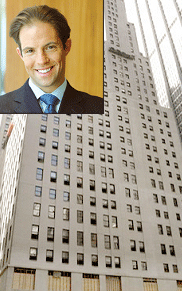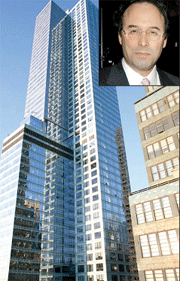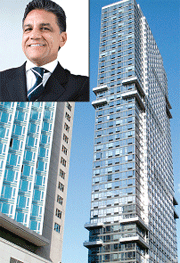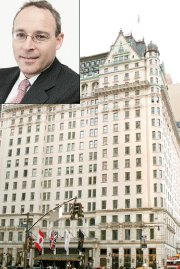The impact of the 2008 real estate crash is by no means limited to the stalled condo projects now sprinkled across the city’s skyline. New developments that sold out quickly — and were deemed great successes at the height of the market — are also facing a unique set of aftershocks from the bursting of the real estate bubble.
Many of the buyers at these buildings were investors more interested in a quick, profitable flip than a place to live. That worked well for a while, but when the music stopped, many buyers were stuck with units they couldn’t afford (and never intended to), often in less-than-desirable locations.
Many buyers “were anticipating the market would do really well, so they counted on being able to sell [investment properties] fairly quickly,” said Allison Scollar, a real estate attorney at Gold Scollar Moshan. “They were never intending to live there, and weren’t necessarily able to carry two apartments.”
When the market crashed, some sued to get out of their contract or walked away from a sizable deposit, but others were forced to close. Now, many are selling their apartments at deep discounts, paving the way for a second round of fallout for new developments.
With data from StreetEasy, The Real Deal looked at some of the buildings where buyers have been hardest hit: once-promising New York City developments, full of individual investors now simultaneously trying to unload their units.
“A lot of investors are finding themselves in a situation where they need to sell,” said Sofia Song, vice president of research at StreetEasy. “A lot of them have to sell at a loss.”
20 Pine

Michael Shvo and 20 PineMarketed by publicity genius Michael Shvo, sales at condo conversion 20 Pine debuted with great fanfare in 2006. With interiors designed by Armani/Casa and a gimmicky 24-hour sales center, the revamped former JPMorgan headquarters made a splash.
“Initially, the building was very successful,” said Shaun Osher, the CEO of the brokerage Core, which specializes in new developments. “They put a lot of units into contract.”
Recently, 20 Pine has gotten more attention for its troubles. It’s been plagued by construction delays, lawsuits and a falling-out between the developers, Lev Leviev and Shaya Boymelgreen.
By January 2009, some 80 units remained unsold, and a group called Venture Capital Properties was reportedly advertising a 51.5 percent discount — around $652 per square foot — if the building’s remaining units were bought in bulk.
To date, only 319 of the building’s 409 total units have closed, according to Street?Easy.
And while the sponsors are marketing the last 80 or so units, many of those who did buy in the building are now struggling to unload their apartments.
For example, unit 3301 was purchased from the sponsor in April 2008 for $2.2 million, city documents show. Three months later, it was back on the market at $3 million, and it’s languished ever since, its price gradually eroding, according to StreetEasy.
Currently, the 1,579-square-foot unit is listed at $2.595 million, or $1,643 per square foot. The listing, with Avenue Real Estate, describes the owner as “a motivated seller.”
The number of resale units on the market at 20 Pine more than doubled between 2008 and 2009, StreetEasy data shows, jumping from 28 to 62. That means nearly 20 percent of the units purchased in the building are available for resale. (There are also more than 40 units currently available for rent.)
“The increase between 2008 and 2009 is very telling,” Song said. “The owners at 20 Pine are desperately trying to rent or sell [their units].”
By contrast, only about 12 percent of units at nearby 15 Broad Street (aka Downtown by Philippe Starck) are on the market.
As much drama as 20 Pine generated, the building’s main problem may be the units themselves, not the lawsuits or developer squabbles. Like many former office buildings, some units at 20 Pine are missing “good light and air,” Osher said. “A lot of them are not perfectly designed for residential living.”
The units were aimed at people who didn’t plan to spend a lot of time in them: investors and young Wall Streeters who worked nearby.
With an abundance of studios and one-bedrooms, the units’ kitchen sinks were only about a foot wide and a foot deep, or as Song put it, “the dimensions of a textbook.”
“There was no way you could consider making a meal,” she said, adding: “They were definitely not trying to appeal to a primary resident. This is for a bachelor who never cooked or washed dishes, or the pied-à-terre buyer who’s always out. It was just impractical.”
With the financial meltdown, investors deserted the marketplace, many bankers suddenly found themselves without job security, and 20 Pine quickly lost its audience.
Other Financial District buildings, like 80 John Street and 15 Broad, had full-size kitchens and features like home offices, and were able to attract families who had been priced out of Tribeca, Song said.
The Orion

Gary Barnett and the OrionThe Orion was a noted success story during the boom, but now it’s a textbook case of the condo crash’s second wave.
The 550-unit Extell project is located amid the hustle and bustle of 42nd Street — not one of the city’s prime residential neighborhoods. But with units initially priced at $1,000 to $1,200 per square foot, it sold out quickly when sales began in 2005.
“There wasn’t that kind of high-end condo in Hell’s Kitchen,” Osher said. “There was a demand for that type of product, and it was certainly priced right.”
The building, with hotel-style amenities such as a free daily breakfast, attracted “a fair amount of international people,” he said.
“It was definitely pied-à-terre buyers and investor-buyers” rather than full-time users, Song said, noting that many of the buyers were Russian and Korean.
The building was especially popular with investors because it allowed buyers to reassign their contracts before they closed, Song said, meaning investors could make a tidy profit without paying closing costs (see “Flipping out over condo flipping”).
Even once all of the sponsor units had closed, units in the building changed hands at a rapid clip.
For example, the sponsor closed on the sale of unit 34E, a one-bedroom, for $855,330 in September 2006, according to city data. Less than a month later, the unit was on the market again with an asking price of $970,000, ultimately selling for $950,000 in November. It went on the market for a third time in July 2009 listed at $1.28 million but has sat on the market since then, and the price has since been reduced to $1.15 million, according to Street?Easy.
“There were rounds and rounds of investors who did make money,” Song said, but once Lehman crashed, “the party was over.”
Many investor-buyers likely planned to rent out their units, but once prices started declining, found they couldn’t get as much income as they’d expected.
“The problem with these mega-buildings is that 400 apartments closed, and suddenly 100 were on the market for rent,” said Corcoran’s Patricia Cliff, senior vice president and director of European sales. “Even from the beginning, they were not good investments.”
As a result, many owners in the building are now selling. The number of resale units at the Orion leaped from 57 in 2007 to 96 in 2009 — about 17 percent of the building’s total units.
The more units that come on the market, the more the average resale price drops.
In 2007, the average asking price of a resale unit in the building was $1.24 million; in 2008, that figure dropped to $1.18 million, and by 2009 it sank to $1.06 million.
Meanwhile, the average asking price per square foot has dropped from $1,314 to $1,259 between 2007 and 2009.
The Atelier

Joe Moinian and the Atelier
Developer Joseph Moinian’s 478-unit Atelier at 635 West 42nd Street has much in common with the Orion, but came on the market later. As a result, the amenity-rich building still had a number of sponsor units to sell when the real estate market crashed.
The fact that the project is located between 11th and 12th avenues, a healthy walk from the subway, didn’t help.
The Atelier has finally sold most of its sponsor units — 470 out of 478 apartments, according to StreetEasy. But the number of resale units at the building has nearly tripled, from 40 in 2008 to 117 in 2009 — about 24 percent of all of the units in the building.
Meanwhile, the median asking price of a resale listing in the building plummeted from $1.2 million in 2008 to $899,000 in 2009, while the average asking price per square foot fell from $1,445 to $1,288.
One challenge the Atelier may have faced is an overreliance on international buyers, who largely disappeared from the market after the real estate crash. While foreign purchasers are now coming back (see “Foreign buyers back — but no more ‘Irish carpenters'”), they are steering clear of buildings of this ilk.
A plan for a group of Irish purchasers to buy 50 units in the building fell through at the eleventh hour when the group couldn’t get financing, and each of the units had to be absorbed by an individual buyer, according to Dan Neiditch, the president of River 2 River Realty and the building’s condo board president.
In a proactive attempt to protect values in their building, residents have made an effort to reduce common charges by cutting costs, Neiditch said.
Those measures ranged from renting out the roof deck for private parties to renegotiating contracts with building staff, he said.
As a result, common charges for residents fell approximately 10 percent as of Jan. 1, Neiditch said.
“I know for a fact that it’s going to help the long-term values of the building,” he said.
The Platinum
When sales at the Platinum began in 2007, the building was best known for risqué ads featuring photographs of models clad only in platinum paint.
Located at 247 West 46th Street at Eighth Avenue, the project initially saw speedy sales: It reportedly hit the 60 percent-sold mark after only six months.
Just over two years later, however, the building’s luck has turned. Now, only 162 of Platinum’s 220 units have closed, according to StreetEasy.
That’s due in part to the location, said Cliff, noting that the building’s Eighth Avenue location also isn’t as desirable as other neighborhoods. While that may not have been a problem during the boom, it appears to be inhibiting sales now that buyers have their pick of discounted Manhattan apartments.
Platinum, too, was popular with investors, experts said.
Despite the fact that a number of units are still on the market, there are already 30 resales available in the building, according to StreetEasy. That’s up from just two in 2008, when the bulk of the closings took place. Resale asking prices actually increased in the building, but that’s likely due to the very small number of resales in 2008. Sponsor units in the building are selling for discounts of 16 to 20 percent off the listing price, according to StreetEasy.
The Plaza

Miki Naftali and the Plaza HotelThe Plaza, one of the most expensive and storied developments of the boom, faced a number of problems. In addition to vehement protests from New Yorkers opposed to the conversion of the landmark hotel, developer Elad Properties battled construction delays, difficulty attracting retail tenants and complaints from buyers unhappy with the finished product.
In addition to all these troubles, what set the Plaza apart from its primary competitor, 15 Central Park West, was a large number of investor-buyers, Song said.
The Plaza and 15 Central Park West came on the market at around the same time, with similar price points and sizes, and both sold out quickly. The two developments had “a lot of the same people walking through their sales centers,” she said.
But while both projects are within spitting distance of Central Park, they are actually in very different neighborhoods. The Plaza sits on Fifth Avenue, directly across from the tourist-mobbed Apple store, while leafy Central Park West is one of the city’s most desirable residential streets.
In addition, the Plaza still has some hotel units, which experts said creates a transient population that is unattractive to full-time residents. At 15 Central Park West, by contrast, “for a lot of [buyers], it is their primary home,” Song said, noting that it helped that the building was built on time, with few disputes. “The Zeckendorfs did a great job. It was a well-run project.”
Ironically, 15 Central Park West buyers have found that the building has held its value better than the investor-heavy Plaza.
By 2009, the average asking price per square foot at the Plaza was $3,978 — while at 15 Central Park West, it was $4,553. That year, the Plaza had 58 resales — nearly a third of the 181 units sold in the building, StreetEasy said. By contrast, 15 Central Park has only 38 resales out of 210 units, or 18 percent.
In addition, units at the Plaza stayed on the market an average of 31 weeks in 2009, while units at 15 Central Park West sold after an average of just 22 weeks.
Recently, units at the Plaza have sold for significant losses. In December, unit 409 closed for $13 million — down from the $21.5 million the buyer paid in 2008.
At 15 Central Park West, however, many sellers are still making money on their units, even in the current downturn. For example, buyers Bruce and Deborah Kaye bought unit 32B from the sponsor for $7.8 million in 2008. In September, they sold it for $11.7 million, city records show.
